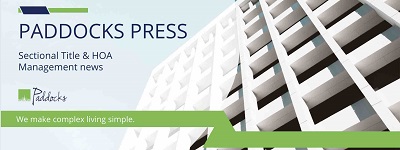Analysis of a CSOS Order - The Attic Altercation at Chenin Body Corporate
By Prof. Graham Paddock

Image: Graham Paddock from Paddocks
In Chenin Body Corporate v Steele (CSOS 4281/WC/21), an owner’s unauthorised attic storage solution led to a dispute with the body corporate. This hidden storage area on community property sparked a legal battle, highlighting one of the challenges of sectional title living.
The Ceiling Storage Surprise
The owner, who was also a resident, converted part of the common property roof ceiling space above his section into a storage attic in 2013. The attic went unnoticed until a neighbour noticed the addition in 2018, sparking concerns among the trustees. The body corporate’s view was that the modifications, which had not received prior body corporate or local authority approval, breached the scheme’s rules regarding common property. The body corporate required the owner to restore the common property space to its original state, citing concerns over structural integrity and fairness to other residents.
At its 2019 AGM the meeting considered the owner’s request for permission to retain the attic roof space, however, permission was refused and members insisted that he return the space to its original state. The owner refused to do so, on the basis that he had used it for nearly five years without complaint. So the body corporate took the matter to the Community Schemes Ombud Service (CSOS), seeking an order under section 39(6)(b) of the CSOS Act of 2011 (CSOSA), that the owner must make repairs to the common property to remove the attic.
Adjudicator’s Order: The Application was Misconceived
The CSOS adjudicator found that the application lacked merit, that the body corporate’s request was “misconceived,” as there was no clear evidence that the attic addition caused any harm or violated other residents’ rights. He advised the trustees to consider ‘a more formal approach’ if they believed the storage increased the section’s floor area in a way that would impact the levy calculations. Having done so, the adjudicator dismissed the application, leaving the attic in place.
Criticism of the Application and the Order
The Adjudicator’s order can be criticised because it appears at least credibly arguable—if not absolutely clear—from the findings of fact recorded in the order that the attic was an extension of the owner’s section floor area used for storage. This could only have been authorised by a body corporate special resolution, as required under section 24 of the Sectional Titles Act of 1986 (STA)—which owners at the AGM made it clear they would not support. If these assumptions are correct, then the effect of the unauthorised extension of section floor area was that the owner obtained a financial advantage at the expense of all other owners, as an extension would have increased his section’s participation quota and his share of scheme levies.
The application can also be criticised because the trustees should not have asked for an order under CSOSA’s section 39(6)(b). They should have identified the attic as an unauthorised section extension and asked for an order under section 39(2)(d), read with sections 54(2) and 3). This would have made it clear that the owner must remove all the articles he had installed to create the common property attic, close the internal access and do all other things necessary to restore the common property to its previous state.
Another less serious criticism of this order is that the adjudicator incorrectly applied the Supreme Court of Appeal’s finding in the case of Mount Edgecombe Country Club Estate Management Association II RF NPC v Singh 2019 (4) SA 471 SCA at par. 19, which confirms the contractual nature of a homeowner’s association’s rules to the body corporate’s rules, and accordingly noted that CSOS wasn’t empowered to intervene unless there was a significant impact on common property or resident wellbeing. A sectional title body corporate’s rules are not contracts—under regulation 6(1) of the Sectional Titles Schemes Management Act of 2011 (STSMA) they “must be considered to be and interpreted as laws made by and for the body corporate of that scheme”.
Takeaways: Attics and Common Property Alterations—Know the Law
This case serves as a reminder for sectional title residents and trustees alike: private modifications that affect common property, such as attics and basements, are not allowed, and all changes to common property must be carried out in accordance with the STSMA and STA. For owners, checking the rules and the law before adding anything—especially if it is not obvious—can prevent headaches. Trustees must either know the law or get legal advice on any owner alterations that affect the shared common property.
In sectional title schemes, every bit of the land and buildings is either part of a section or part of the common property. Sometimes, a bit of research or some expert legal advice can either avoid a CSOS application, or make sure you get your order!
Courtesy: Paddocks Press

Article reference: Paddocks Press: Volume 19, Issue 11.
Weblink: https://www.paddocks.co.za/paddocks-press-newsletter/the-attic-altercation/
This article is published under the Creative Commons Attribution license.






